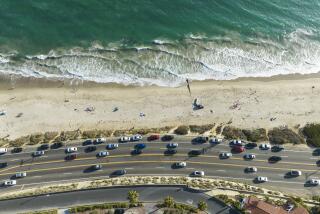Runoff Is Far Greater Threat to Coast Than Sewage Plume
Most people believe that more should be done to protect our coastal ocean and beaches, but disagreements arise over what should be done and who should pay. A case in point is the situation at Huntington Beach, where three years of beach postings and closures have frustrated the public and spawned growing rancor over whether the Orange County Sanitation District should upgrade to full secondary treatment of sewage.
As a scientist studying coastal pollution, and the person frequently cited as suggesting a link between the sewage plume and surf pollution at Huntington Beach, I think that the debate over secondary treatment is probably, well, secondary.
Full secondary treatment would reduce the levels of organic contaminants, viruses and bacteria, released to the ocean. But so far there is no evidence that the extra treatment, at a cost of $400 million, would make Huntington Beach’s water quality problems go away. What’s more, sewage treated to full secondary standards still harbors enough viruses and bacteria to pose a significant health risk to recreational bathers if the plume comes ashore.
So what’s the solution? The sanitation district’s plan to partially disinfect their sewage is a good start, particularly if it can be done in a way that won’t harm the environment. Unlike secondary treatment, disinfection targets the contaminants of greatest concern (protozoa, bacteria and viruses) and does it at a fraction of the cost of secondary treatment. It’s also a great experiment: If the surf at Huntington Beach doesn’t clean up after the start of disinfection, then the sewage plume can’t be the main culprit.
But the truth is that street runoff is a far greater threat to coastal water quality than the sewage plume. During dry weather, runoff is generated by over-irrigation of lawns, car washing and other activities that send excess water into storm drains. From there the runoff picks up bacteria, viruses and other pollutants as it flows to the coast, where it enters the ocean at the surf line.
Recent efforts to divert runoff to the sanitary sewer system are a wise expenditure of public and private funds that appears to be improving surf water quality.
According to a recent epidemiological study in Santa Monica Bay, the runoff diversions may also reduce the number of people who get sick after recreating in the ocean. Expanding the runoff diversions to include wintertime dry-weather periods (most diversions operate from June through September) and finding ways to waste less water (by using next-generation irrigation systems, for example) would also help.
However, the real challenge will be to find ways of treating the torrents of runoff, in some cases generated by inland communities dozens of miles from the beach, that flow into the ocean during storms.
The root problem at Huntington Beach is not contaminated surf, per se, but the way California manages and regulates coastal water quality. Because different sources of pollution are, in effect, owned by different agencies, there is a tendency for these agencies to focus on blame shifting rather than identifying and fixing sources of pollution.
The situation would improve if, as recommended several years ago by a USC/Sea Grant blue-ribbon panel, water-quality investigations were carried out by a neutral third party. This third party would impartially investigate all potential sources of contamination, and prioritize water-quality projects based on their likely benefits and cost. Finding funding for this new agency might be difficult, although the money currently contemplated for secondary treatment would make a great down payment.
The situation at Huntington Beach exposed weaknesses not only in the way we manage and regulate coastal pollution, but also in the way we study it. Coastal pollution is a maddeningly trans-disciplinary problem, equal parts microbiology, ecology, physical oceanography, environmental engineering and political science.
For scientists, the biggest challenge is overcoming the disciplinary arrogance that typifies our enterprise, to find creative new ways of identifying, mitigating and managing sources of pollution. In the process, we are creating a whole new research field, call it coastal water quality science, that will be a critical player in the years to come.
More to Read
Sign up for Essential California
The most important California stories and recommendations in your inbox every morning.
You may occasionally receive promotional content from the Los Angeles Times.










